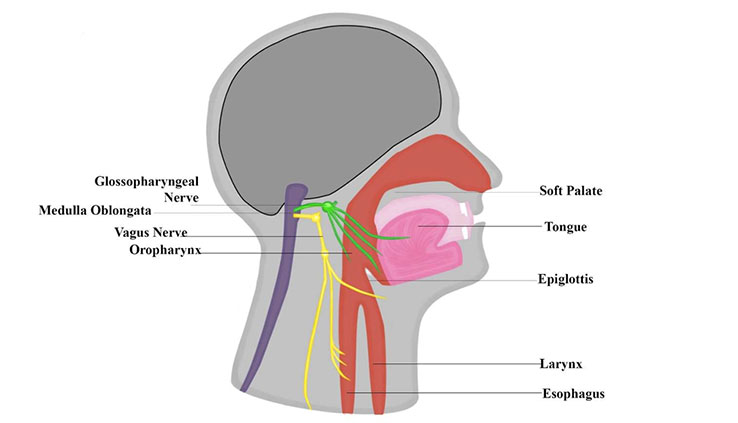Why is My Gag Reflex More Sensitive at the Dentist?
- Published28 Aug 2023
- Author Levi Gadye
- Source BrainFacts/SfN

“Open wide. A little bit wider. Now bite down. You’ve got it. Just a few more seconds.”
Every day in dental offices around the world, these words are spoken as part of routine teeth cleanings and check-ups. But for some people, such words alone — or the placement of an X-ray film — can trigger an unpleasant reaction known as the gag reflex.
The gag reflex can prevent choking, but it can also pose issues when the throat is overly sensitive. BrainFacts.org spoke with Liran Levin, a dentist and professor of periodontology at the University of Alberta in Canada who has conducted many studies on the gag reflex as well as ways to manage it in the dentist’s office.
What is the gag reflex?
The gag reflex is our body’s reaction to something happening inside your mouth, perhaps a dental treatment or an examination from a physician, that protects us from choking. It’s related to coughing. These reflexes are supposed to preserve the airway and enable comfortable breathing.
In everyday life, we eat and it doesn’t trigger the gag reflex. Consider a piece of bread or something, which is much bigger than what a dentist puts into your mouth. It's not that you're not capable of having something in your mouth. Instead, it relates to the context — should something be in my mouth?
For many individuals, even a small stimulus can create the gag reflex, and that can become problematic. In many cases you won’t feel it day-to-day, but during examinations related to your mouth, like dental treatment, there might be a problem.
How does the gag reflex work?
The gag reflex occurs when muscles contract in the pharynx (the part of the throat that connects the mouth, nose, airway, and digestive system), forcing out anything that’s stuck — the opposite of swallowing.

In a minority of cases, it may be purely physiological: a neurologic relaying of stimuli from your palate to the brain. Sometimes when we numb a person’s mouth, they’ll feel only half of a stimulus — the tongue will feel something, but the palate will not. And the brain will interpret that difference as, “Uh oh, I have something stuck in the back of my mouth.”
In other cases, there can be psychological reasons for a stronger gag reflex, both in terms of dental treatments and in terms of past trauma, and our prior experiences can trigger the gag reflex directly.
Why do some people have such sensitive gag reflexes?
In dentistry, it’s often anxiety, which varies between people. Many people are afraid of the dentist. It isn’t deliberate, it’s unconscious. From their perspective, genuinely, they feel that whenever the dentist puts something in their mouth, they feel the need to gag.
Sometimes, people may have other trauma relating to the oral cavity, leading to a sensitive gag reflex, but many, many people deal with this at the dentist’s office.
How can the gag reflex be improved in the dentist’s office?
When a patient feels a stimulus in their mouth, the first instance of the gag reflex might be mostly neurological. But then, the patient starts to think, “Oh my god, I’m going to choke,” then they’re stressing out about it, and are more likely to gag again from an even smaller stimulus, creating a vicious circle
As a dentist, when you see this happening, sometimes just sitting a patient back and talking to them quietly, explaining to them what they’re feeling, can interrupt the cycle. If we show them they can breathe, they can swallow, it can help them relax. There’s a big component of consciously understanding that what’s happening is not life-threatening, there’s no real danger to the airway, that can lead to controlling it.
There are a lot of behavioral techniques we can use, too. In the dentist’s office, we can have patients help us with the instrument, or move toothbrushes together, the same movements they’ll encounter during a dental procedure itself, and they will retrain themselves to not gag. The key is to take it slow.
References
Debs, N. N., & Aboujaoude, S. (2017). Effectiveness of intellectual distraction on gagging and anxiety management in children: A prospective clinical study. Journal of International Society of Preventive and Community Dentistry, 7(6), 315. https://doi.org/10.4103/jispcd.jispcd_397_17
Nichols, Hayley, "Gag reflex and disgust sensitivity in selective eaters" (2018). WWU Graduate School Collection. 697. https://cedar.wwu.edu/wwuet/697
Sivakumar, S. (2023, March 12). Physiology, Gag Reflex. StatPearls - NCBI Bookshelf. https://www.ncbi.nlm.nih.gov/books/NBK554502/
BrainFacts.org welcomes all your brain-related questions.
Every month, we choose one reader question and get an answer from a top neuroscientist. Always been curious about something?
Please submit your question by filling out this form.







